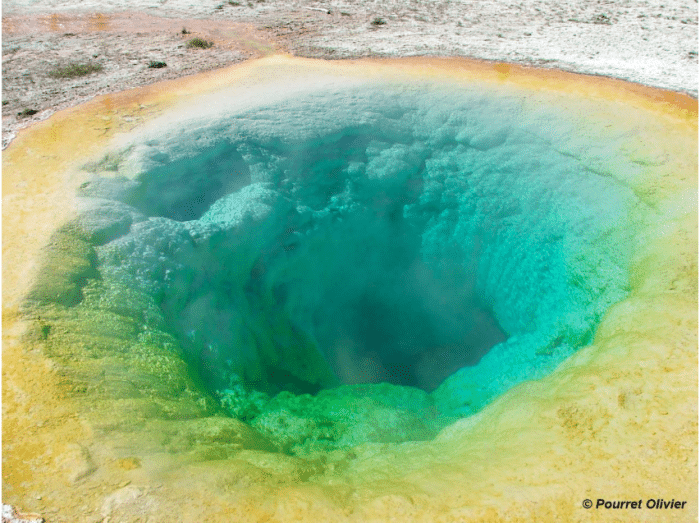
It all started in 2005 during a trip to the United States, where I went to a famous conference in geochemistry (Goldschmidt Conference, Moscow, Idaho). The following weeks I crossed the Rocky Mountains and visited many national parks, including Yellowstone Park.
Of the many geological, geothermal, and volcanic curiosities in Yellowstone National Park, and outside of the wildlife (including some incredible photographs of bison), I have been fascinated by hot springs and associated thermophile organisms, such as this photograph of the Morning Glory Pool, north of the Old Faithful Geyser (Figure 1). The orange and yellow bacteria thrive in cooler waters by secreting siderophores (or metallophores) favoring the precipitation of iron (Fe) and manganese (Mn) oxides, while in higher temperatures we find blue or green bacteria. Bacteria grow massively when the temperature of hot springs drops.

Figure 1. Photograph of the Morning Glory Pool at Yelloswtone (May 2005)
Siderophores or metallophores are chelating molecules of iron produced by microorganisms when intracellular iron concentrations are low, which allows them to “draw” the iron necessary for their development from the environment. These molecules of low molecular weight have a very strong affinity for trivalent iron Fe(III) and are capable of forming [siderophore-Fe(III)] complexes that will internalize the iron necessary for the functioning of the cell.
Generally, siderophores are classified by their functional groups as catecholates, hydroxamates, and hydroxycarboxylates. Other structural, chemical, and functional group modifications have also been observed. The functional groups participate in the iron chelation process when the [siderophore-Fe(III)] complex is formed. Acidophiles, alkaliphiles, halophiles, thermophiles, psychrophiles, piezophiles, and extremophiles have particular iron requirements depending on the environmental conditions in which they develop.
Most of the research that is concerned with the production of siderophores by extremophiles is based on siderophore concentration and/or genomic studies determining the presence of siderophore synthesis and transport genes. The siderophores produced by extremophiles are poorly known and much remains to be done to elucidate the chemical structures and their role in the survival of microorganisms and the cycles of metals in extreme environments.
In this context, we realized with colleagues from Jacobs University in Bremen, Germany (under the direction of Michael Bau), rare earth element (REE) sorption and modeling experiments on manganese oxides in the presence of a biogenic compound of desferrioxamine B type (DFOB). This compound belongs to the group of metal-specific organic ligands commonly called siderophores that I just briefly described above. These low molecular weight organic molecules are synthesized by bacteria and plants in oxidized environments to cope with the iron deficiency of the medium. In oxidized systems, iron is present in its trivalent form and is, therefore, immediately fixed in insoluble oxyhydroxide structures and thus removed from the aqueous solution.
Therefore, under modern atmospheric conditions, the essential nutrient Fe is not available to organisms, and siderophores are excreted by plants, microbes, and fungi to facilitate the dissolution of iron oxides. However, it has recently been shown that siderophores not only form very stable complexes with Fe (III) but also significantly complex other polyvalent metal ions, some of which are considered toxic at higher concentrations but are essential nutrients at trace concentrations. Several studies have shown that siderophore chelation of metals reduces metal uptake by bacteria, fungi, and plants, and siderophores play a vital role in the detoxification of metals.
In the absence of siderophores, trivalent Ce is surface-oxidized to Ce(IV) during sorption onto Mn (hydr)oxides. Such Mn precipitates often show positive Ce anomalies, whereas the ambient solutions display negative ones. However, REE scavenging in the presence of DFOB produces negative Ce anomalies in the Mn (hydr)oxides and a distinct and characteristic positive Ce anomaly in the siderophore-bearing solution. Furthermore, the heavy REE (Tb to Lu) also remains in the solution, creating strongly Ce and HREE-enriched residual solutions during scavenging of REE onto Mn (hydr)oxides. This process efficiently separates light REE (La to Gd, excluding Ce) from HREE. Such preferential partitioning of Ce into the residual aqueous phase has been described in the literature for natural Mn (hydr)oxides, but the mechanism for this is still unclear.
Our experimental results demonstrate that biogenic organic ligands such as siderophores that form very strong aqueous complexes with Ce4+ may produce solutions with positive Ce anomalies and Mn (hydr)oxide minerals with negative Ce anomalies, complicating the use of Ce anomalies as paleoredox proxies.
These findings are described in the article entitled Negative cerium anomalies in manganese (hydr)oxide precipitates due to cerium oxidation in the presence of dissolved siderophores, recently published in the journal Geochimica and Cosmochimica Acta. This work was conducted by Dennis Kraemer, Nathalie Tepe, and Michael Bau from Jacobs University Bremen, and Olivier Pourret from UniLaSalle.
Reference:
- Kraemer, D.; Tepe, N.; Pourret, O.; Bau, M., Negative cerium anomalies in manganese (hydr)oxide precipitates due to cerium oxidation in the presence of dissolved siderophores. Geochimica et Cosmochimica Acta 2017, 196, 197-208.









